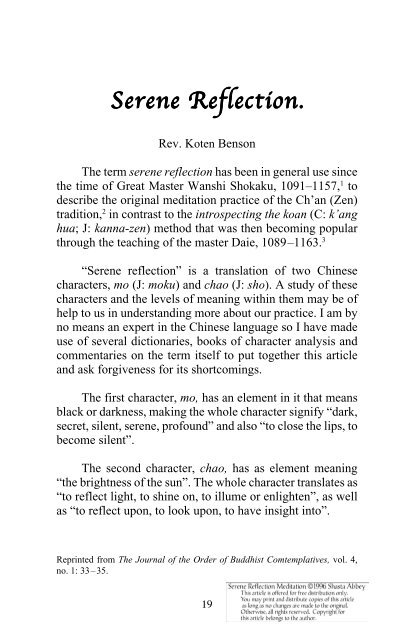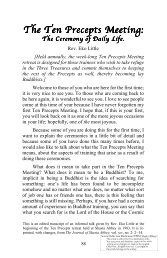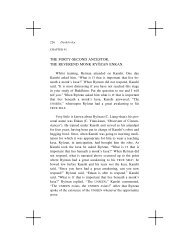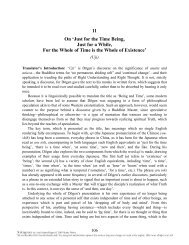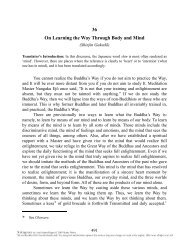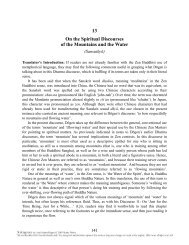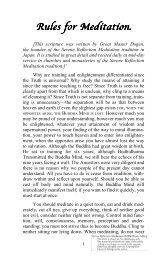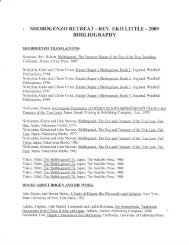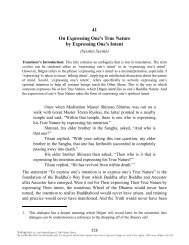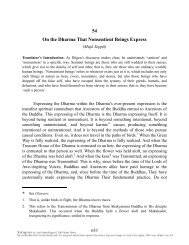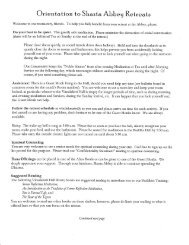Serene Reflection. - Shasta Abbey
Serene Reflection. - Shasta Abbey
Serene Reflection. - Shasta Abbey
You also want an ePaper? Increase the reach of your titles
YUMPU automatically turns print PDFs into web optimized ePapers that Google loves.
<strong>Serene</strong> <strong>Reflection</strong>.<br />
Rev. Koten Benson<br />
The term serene reflection has been in general use since<br />
the time of Great Master Wanshi Shokaku, 1091–1157, 1 to<br />
describe the original meditation practice of the Ch’an (Zen)<br />
tradition, 2 in contrast to the introspecting the koan (C: k’ang<br />
hua; J: kanna-zen) method that was then becoming popular<br />
through the teaching of the master Daie, 1089 –1163. 3<br />
“<strong>Serene</strong> reflection” is a translation of two Chinese<br />
characters, mo (J: moku) and chao (J: sho). A study of these<br />
characters and the levels of meaning within them may be of<br />
help to us in understanding more about our practice. I am by<br />
no means an expert in the Chinese language so I have made<br />
use of several dictionaries, books of character analysis and<br />
commentaries on the term itself to put together this article<br />
and ask forgiveness for its shortcomings.<br />
The first character, mo, has an element in it that means<br />
black or darkness, making the whole character signify “dark,<br />
secret, silent, serene, profound” and also “to close the lips, to<br />
become silent”.<br />
The second character, chao, has as element meaning<br />
“the brightness of the sun”. The whole character translates as<br />
“to reflect light, to shine on, to illume or enlighten”, as well<br />
as “to reflect upon, to look upon, to have insight into”.<br />
Reprinted from The Journal of the Order of Buddhist Comtemplatives, vol. 4,<br />
no. 1: 33 – 35.<br />
19
20 <strong>Serene</strong> <strong>Reflection</strong>.<br />
The whole term thus becomes “serene reflection”,<br />
“silent illumination”<br />
4<br />
or “luminescent darkness”. 5 In the<br />
very description of our practice we have the ‘light in<br />
darkness—darkness in light’ spoken of in the works of the<br />
great masters of our tradition. 6<br />
We can also see in this the origin of the references to<br />
the reflection of the moon in water. As the water of the spirit<br />
within us becomes still, clean and bright through meditation,<br />
so does the reflection of the “moon”, of the Eternal, become<br />
clear and True. There is more than “stillness” in this, more<br />
than mere quietism. The water must be clear and bright and<br />
clean or there will only be the false “stillness” of stagnation,<br />
a dirty pool in which the moon’s reflection will be dim and<br />
shallow. This is why we are warned about the consequences<br />
of clinging to blissful states and urged to maintain a bright<br />
mind while meditating—the importance of the ‘stillness<br />
within activity and activity within stillness’.<br />
Another important point in the characters is that there is<br />
no “thing” that can be grasped as the source of the light nor a<br />
“thing” that reflects the shining. Neither is the darkness or<br />
silence a “thing” that can be grasped. This is because in the<br />
face-to-face encounter with the Eternal of meditation there is<br />
no separate self, just the serene, profound, illuminating light.<br />
Dogen says it better than I:<br />
Lament impurity.<br />
Within the silent waters of the heart<br />
Dwells the moon, the lonely waves—<br />
Brightness everywhere. 7<br />
* * *
<strong>Serene</strong> <strong>Reflection</strong>. 21<br />
Notes.<br />
1. Hung Chih Cheng Chueh, disciple of Tanka Shijun, author of Mo<br />
Chao Ming (Notes on <strong>Serene</strong> <strong>Reflection</strong>).<br />
2. Chang, The Practice of Zen, pp. 66 – 69.<br />
3. Ta Hui Tsung Kao (J: Daie Soko).<br />
4. Another translation of mo chao.<br />
5. See Rev. Master P.T.N.H. Jiyu-Kennett, M.O.B.C., How to Grow a<br />
Lotus Blossom or How a Zen Buddhist Prepares for Death, 2nd ed. rev.<br />
(Mount <strong>Shasta</strong>, California: <strong>Shasta</strong> <strong>Abbey</strong>, 1993), p. 165.<br />
6. See Hsin Hsin Ming (Faith in Mind) by Kanchi Sosan; Ts’an T’ung<br />
Ch’i (Sandokai) by Sekito Kisen; Pao Ching San Mei Ko (The Most<br />
Excellent Mirror–Samadhi) by Tozan Ryokai; Mo Chao Ming (Notes on<br />
<strong>Serene</strong> <strong>Reflection</strong>) by Wanshi Shokaku; “Ko Myo” (“Divine Light”),<br />
chapter 13 of Shobogenzo Dogen; Komyozo-Zanmai (Samadhi of the<br />
Treasury of the Radiant Light) by Koun Ejo and many other works in<br />
various translations.<br />
7. See The Story of Rev. Dogen, translated from the Japanese by Rev.<br />
P.T.N.H. Jiyu-Kennett.<br />
Bibliography.<br />
1. Chang, Garma C.C. The Practice of Zen. New York: Harper and<br />
Row, 1959.<br />
2. Kodera, Takashi. Dogen’s Formative Years in China. Boulder,<br />
Colorado: Prajña Press, 1980.<br />
3. Mathews, R. H. Mathews’ Chinese English Dictionary. Cambridge,<br />
Massachusetts: Harvard University Press, 1948.<br />
4. Okumura, Shohaku. Shikantaza: An Introduction to Zazen. Kyoto,<br />
Japan: Kyoto Soto Zen Center, 1985<br />
5. Sheng-Yen, Master. The Poetry of Enlightenment: Poems by Ancient<br />
Ch’an Masters. Elmhurst, New York: Dharma Drum Publications, 1987.<br />
6. Soothill, William Edward and Lewis Hodous. A Dictionary of<br />
Chinese Buddhist Terms. Taipei, Taiwan: Buddhist Cultural Service.<br />
and various and sundry dictionaries, footnotes, hints, etc., in many<br />
books.


